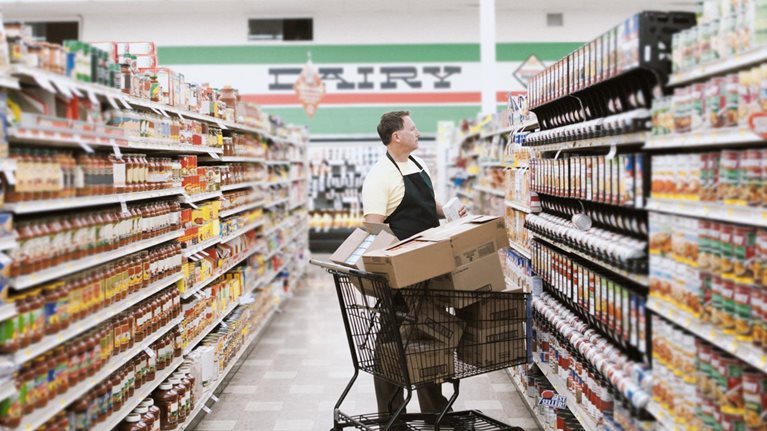With much of the world’s population being asked or required to stay home and follow physical-distancing guidelines, once-bustling restaurants and cafés now sit empty. Although a few quick-service restaurants (QSRs) are seeing heightened demand in takeout and delivery—several US pizza chains, for instance, are hiring thousands of workers as orders spike—most other QSRs have experienced dramatic sales declines. Some have closed their doors for good.
The coronavirus pandemic is a humanitarian crisis whose economic impact will almost certainly be severe as well. As our colleagues wrote in a recent article, “The required ‘lockdowns’ of the population and other efforts to control the virus are likely to lead to the largest quarterly decline in economic activity since 1933.” They expect an unprecedented 40 to 50 percent decline in discretionary spending—a roughly 10 percent reduction in GDP. (See McKinsey.com/coronavirus for our most up-to-date insights.)
The QSR industry has been hit particularly hard. A few restaurants have already declared bankruptcy; others report that they soon won’t be able to cover their rent and personnel costs. In the United States alone, up to seven million restaurant workers could lose their jobs by June, according to the National Restaurant Association.
Undeniably, QSRs face tough decisions in the coming weeks and months. But some QSRs will fare better than others, depending on their starting point and the actions their leadership teams take. This article lays out a series of practices—critical for “navigating the now,” planning the comeback, and shaping the future—that can help QSRs not just survive the current crisis but also position themselves to succeed in the “next normal.”
COVID-19’s impact on consumer behavior
In many countries, QSRs are either closed entirely or operating on a limited basis, offering only takeout, pickup, delivery, drive-through, or some combination of those options. Even among QSRs that remain open, the drop-off in business has been steep. Consumer-sentiment surveys that McKinsey conducted in late March across Europe and the United States indicate that during the crisis, most consumers expect to reduce their spending on all restaurant food—takeout and delivery, QSRs, and other types of restaurants.
Meanwhile, in China, where physical-distancing restrictions have already been loosened, consumer-sentiment surveys reveal the following three trends (exhibit) that could play out in other geographies as well:
- Postcrisis spending on in-restaurant dining is expected to be lower than precrisis levels, largely because consumers will still be wary of being in densely populated public spaces.
- Demand for takeout is expected to return to precrisis levels fairly quickly.
- After the pandemic, consumers will likely spend more on food delivery, prepared foods, and groceries than they did before the pandemic. Again, because of financial strains and lingering concerns about eating in crowded places, consumers will likely continue to prefer eating at home, at least for a time.
The specific challenges each QSR faces during this crisis are unique, depending on the company’s financial and market position and the pandemic’s timing and progression in local markets. But every company can take inspiration from what some of its counterparts around the world are doing.
Actions to consider, both for now and for later
Drawing on lessons from the past several weeks, we have identified a set of actions for QSR executives to consider during these challenging times.
‘Navigate the now’: Short-term priorities
While QSRs should stay abreast of how the situation evolves, they should take immediate action in certain critical areas. Short-term priorities for QSRs during the crisis include the following:
Protecting employees and customers
By now, most QSR players have established new health and safety processes and policies to protect employees and customers. Some of the practices QSRs have implemented include adjusting travel policies to permit only the most critical business travel, encouraging or requiring remote working for corporate staff, and amending sick-leave policies for employees affected by COVID-19. QSRs have also adjusted their on-site offerings to follow local and national guidelines—for example, by shutting down self-serve prepared-food counters, suspending all customer events, and switching to a delivery-only model.
With regard to hygiene and safety, QSRs have instituted strict protocols, such as providing hand sanitizer and thermometers and training employees to minimize human contact. In addition, most QSRs have increased the frequency and rigor of in-store cleanings, making sure to sanitize high-touch areas (such as counters, self-checkout screens, and door handles on coolers and freezers).
Safeguarding the top line
Despite physical-distancing regulations, restaurants can continue to generate sales. In localities that prohibit on-premise dining, QSRs have ramped up their takeout and delivery capabilities and adopted new marketing tactics to reach consumers who may not actively be searching for these services.
- Doubling down on the online channel. Many QSRs that built their own online-ordering mechanisms on their websites or mobile apps are working to make sure these can handle an increase in demand. Meanwhile, companies that don’t have their own online capabilities are partnering with call centers, delivery aggregators, and other third-party providers—though serving customers through such partnerships yields significantly lower margins (because aggregators, for instance, typically take 25 to 30 percent of the value of each transaction). In either case, restaurants are finding that they need to expand their delivery fleets. Some are reassigning in-store employees to assist with delivery operations.
- Simplifying kitchen operations while meeting customers’ changing needs. During this crisis, consumers have become more willing to have a broad array of food products delivered to their homes. For example, beverages, bread, and fruit—products that consumers have historically preferred to consume in restaurants or buy in grocery stores—now increasingly appear in restaurant-delivery orders. Some restaurants are therefore expanding their delivery menus, giving customers more choices in both fresh and prepared foods and even, in some cases, offering meal kits that customers can put together at home. However, QSRs recognize the need to simplify their operations to avoid putting further stress on an already-strained workforce. They are therefore striving to meet new consumer needs without making kitchen operations more complex.
- Sending targeted customer communications. Communicating with customers is especially important for QSRs during this time, as restaurants face increased competition from home cooking. With people spending almost all their time at home, QSRs are shifting their marketing spend to home-based channels, such as TV or online, and from sports channels to news outlets. They are also securing preferred placement in food-delivery apps. In addition, some QSRs are engaging with trade associations and industry experts to ensure the appropriateness and accuracy of their marketing messages (for instance, in ads emphasizing safety of food delivery or takeout).
Stabilizing the supply chain
Restaurants need a reliable supply chain—not just for food ingredients but also for essential supplies to keep the business running: disposable paper goods (such as napkins and food cartons), cleaning products, spare parts for the vans and motorbikes used for food deliveries, and so forth. To minimize the risk of disruption in the supply chain, QSRs are taking a range of actions, such as limiting menus to match what they can predictably source, substituting frozen products for fresh products when necessary, revising purchase orders to align with demand, identifying alternate suppliers, and collaborating with manufacturers to create contingency plans. To support small and midsize suppliers that might be struggling during the crisis, some cash-rich QSRs are adjusting payment terms or offering temporary loan options. A handful of forward-thinking QSRs are also taking advantage of historically low commodity prices (of oil and chicken, for instance) by purchasing ahead where possible or by pre-booking freight capacity.
Managing cash
Most QSRs can expect to generate only a small fraction of their normal revenues for the foreseeable future, so cash management is a clear priority. Some QSRs have established a “cash lab”—a central team with full visibility into cash forecasting and optimization. The cash lab stays on top of regulatory developments in each market so that, where appropriate, the company can receive government aid, benefit from tax deferrals or credits, or apply for federal loans as quickly as possible.
To conserve cash, QSR leaders are postponing or renegotiating rent payments, deferring noncritical indirect spend and capital expenditures, and reducing personnel costs through hiring freezes and efforts to take advantage of government-funded programs, such as Germany’s Kurzarbeit, or “short-time work” wage subsidy. In addition, they are preparing clear and detailed messages for investors about their plans for generating cash and the timing of those initiatives.
Modeling a range of scenarios
When will people start eating in restaurants again? The answer will be different everywhere—but we expect the mandated closures to extend beyond the dates originally announced, at least in Europe and the United States. And we expect that, for health and safety reasons, restaurant dining rooms will be among the last businesses that will be allowed to reopen. The timing of recovery will also vary by country. We see China recovering ahead of many western countries including Italy and the United States.
For QSR players with locations in multiple markets, one crucial exercise is to model three-month, six-month, and 12-month scenarios for each market and to develop concrete action plans for every scenario. If, for instance, restaurants remain shut in six months’ time, QSRs may need to reduce fixed costs drastically by renegotiating leases and credit terms or by selling real estate. If restaurant closures last even longer than six months, some companies may need to seek new lines of credit, divest business units, or even put themselves up for sale.
Ideally, this kind of scenario modeling and contingency planning will be among the responsibilities of a COVID-19 nerve center—a cross-functional team that has access to real-time data on how the situation is evolving. This team helps ensure that company leaders are aligned on the scenarios as well as on the portfolio of actions for each scenario.
Plan the comeback: Medium-term actions
As stay-at-home mandates begin to lift and restaurants reopen, QSRs will need to have plans in place to capture returning demand. A return to previous demand levels won’t happen right away, so QSRs will need to take a phased approach to bringing back labor, dine-in operations, and supply-chain support.
In the immediate postcrisis period, we see QSR companies choosing between two sets of strategic actions, depending largely on each QSR’s financial and competitive position. Companies with low liquidity and weak competitive differentiators would need to pursue “preserve and grow” actions. On the other hand, companies with strong financial fundamentals and competitive advantages can aggressively build on their strengths. QSR companies that entered the crisis from a position of strength will, of course, have more options and greater flexibility in preparing for the recovery.
‘Preserve and grow’
Some QSRs entered the crisis in an already precarious cash position. Broadly speaking, these players tend to have a few attributes in common: a heavy reliance on their brick-and-mortar restaurants, a minimal presence in digital and delivery channels, menus that aren’t sufficiently differentiated from those of competitors, and limited loyalty programs. They also tend to be more prone to supply-chain instability because of a small and dispersed supplier base.
During the crisis, these companies will be focused on avoiding bankruptcy; they need to find ways of adapting their offerings while conserving cash. But even during the recovery period, cash-poor restaurants will need to keep instilling a cash-conscious culture at all levels of the organization. They’ll need to remain vigilant with their spending, in part as a cautionary measure in the event of a resurgence of the coronavirus. For these companies, continuing to create weekly cash-flow projections and to conduct financial-health evaluations regularly across the network will be important. They also should consider renegotiating contracts to increase flexibility—for example, by tying rent to revenue.
At the same time, cash-constrained QSRs should constantly communicate with their customers, particularly their most loyal ones, who will be their best lever for increasing demand once restaurants reopen. To make sure that brand communications are consistently sensitive and will resonate with the customer base, QSRs should run frequent “pulse checks” on consumer sentiment.
And of course, an important “preserve and grow” action for QSRs will be to continue to prioritize hygiene and safety while controlling costs. Companies will need to establish stringent labor processes and schedules in their restaurants; some might consider simplifying menus to further reduce complexity in kitchen operations.
‘Build on strengths’
Other QSRs, by contrast, entered the crisis with strong liquidity positions. These financially stable companies tend to have well-established digital and delivery channels and strong loyalty programs. Most have invested in the supply chain by building up a stable supplier base and developing contingency plans to minimize supply-chain disruptions in times of crisis.
During the recovery, these companies can accelerate growth by increasing their investments in mobile and delivery solutions, offering value-meal and family-meal promotions, and focusing on occasions that saw the biggest declines during the crisis (such as breakfast on the way to work). They can entice customers to return to on-premise dining with attractive promotions and new menu offerings. They might also consider launching task forces to conduct competitive scans: in some markets, competitors may either be struggling or have closed locations. QSRs could step up their marketing efforts in those areas to capture market share.
Stronger companies can also leverage their cash positions for disruptive moves: they might, for instance, make anticyclical investments, purchase real estate, or acquire distressed competitors, business units, or brands. As QSR companies seek to form partnerships or make acquisitions, they should consider not just economic rationales but social rationales as well—for example, could a particular M&A deal keep another company afloat, save jobs in a struggling community, or strengthen the restaurant industry for the longer term?
Shape the next normal: Long-term considerations
As the crisis subsides, all QSRs must prepare for the coming shifts, in consumer mindsets and behavior, that will shape the industry’s next normal. The following are some of the changes we believe are possible:
- Greater concern about hygiene and safety. Consumers will demand much more information about what ingredients are in restaurant food, where it comes from, how it’s prepared, and by whom. Sanitization will become a significant focus for restaurants; day-to-day operating costs will increase as a result. Food-packaging costs may also rise. Contactless delivery and pickup may become the norm.
- Stronger demand for digital and delivery. The competitive landscape in food delivery will be transformed as QSR players build internal capabilities, invest in next-generation technology (such as delivery drones), or join forces with third-party providers. Loyalty programs will become more robust as QSRs look to increase “stickiness” among customers. Some QSRs may also reformat their locations—for instance, by shrinking seating areas and increasing drive-through capacity.
- Shift in spending from QSRs to grocery stores. Early signs indicate that some of the shift from spending in restaurants to spending in grocery stores will persist in a post-coronavirus world. To supplement these losses, QSRs can look for additional revenue streams; more QSR players may, for example, consider launching grocery product lines or expanding into new channels, such as B2B catering. In response to lower sales levels, some QSRs may also consider reevaluating their corporate costs, restaurant networks, and franchisee base.
- Increased focus on supply-chain management. The COVID-19 crisis is exposing weaknesses in many QSR supply chains and highlighting the importance of flexibility and adaptability. This challenge will galvanize QSRs to invest in supply-chain technology and capacity so that they can better—and more rapidly—align supply with demand. Many QSRs also experienced supply-chain disruptions as a result of labor shortages during the crisis, and that may lead them to accelerate their investments in supply-chain automation.
QSRs need an operating model that can accommodate the extreme level of uncertainty facing the industry. Two practical steps they can take to guide their decision making are to launch a “plan-ahead team” and to direct that team to work across multiple time horizons.
The QSR business, by definition, is about serving customers at speed. We believe that if QSRs act quickly in this crisis to meet the changing needs of consumers while prioritizing people’s health and well-being, QSRs can not only withstand these difficult times but also build valuable capabilities for resilience and success in the future.


